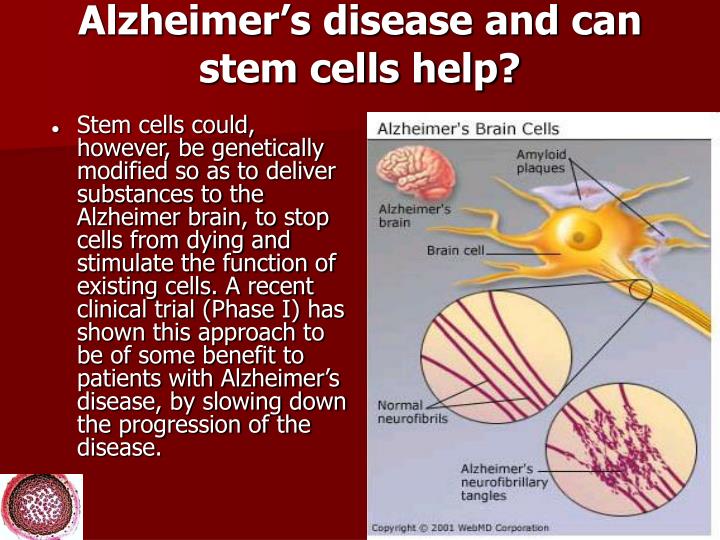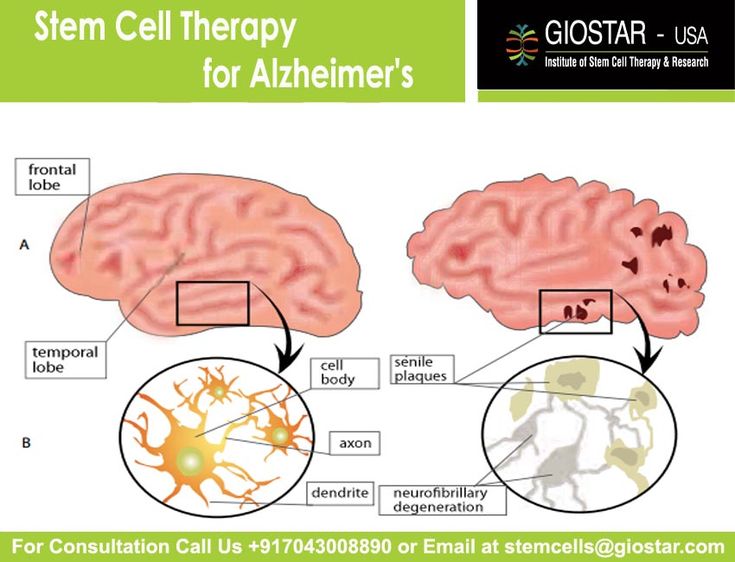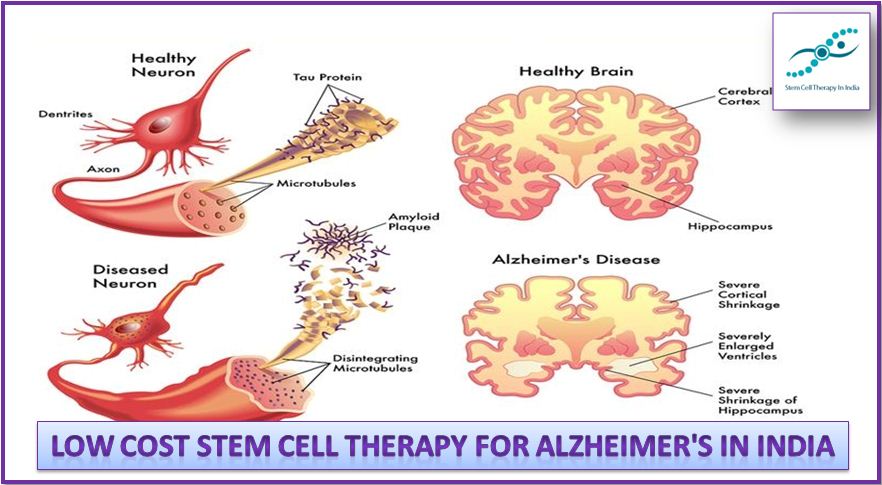Why Mesenchymal Stem Cells
Mesenchymal stem cells are specially harnessed from the patients in the treatment of AD as they are easily available and for their ease of differentiating into potential neuronal cell types. They have the blood-brain barrier penetration property, are low on tumorigenicity and can incite an immune response. The bone marrow-derived mesenchymal cells increase their immune-modulatory ability by the releasing soluble factors and secreting neurotrophic factors.
The beneficial properties of mesenchymal cells stimulate the proliferation and survival of the dead or damaged tissues and nerve cells. Their anti-inflammatory and immune modulatory properties also contribute to the recovery in patients with Alzheimers disease. Thus, the consistency of MSCs is supposedly embedded in phenotypic expression and differentiation and based on its safety and effectiveness.
Cell treatment for AD may not completely cure the patients but can help them to gain control over their relapses.
Cell Therapy is beneficial for many types of disorders that are said to be beyond restoration. They includes neurological disorders such as cerebral palsy, autism, muscular dystrophy, brain stroke, spinal cord injury, brain injury, etc. Various hospitals around the globe utilize mesenchymal cells to regenerate functional tissues and damaged or injured organs.
The Role Of Stem Cells In Treating Alzheimers Disease
Stem cells are those cells that can easily become the cells of different organs where their need arises. This means that stem cells can evolve into cells of the brain, heart, muscle, organ, tissue or cartilage and so to treat many complex diseases such as Alzheimers Disease, Parkinsons Disease, Diabetes, Rheumatoid Arthritis, etc. Stem cell therapy is at the heart of a new field of science and medicine called regenerative medicine.
Since stem cells have the unique ability to renew themselves and give birth to generations of cells with different degrees of differentiation, the use of this therapy becomes extremely encouraging and promising for those who suffer with debilitating diseases. They also replace damaged cells in different body parts without any risk of being rejected and without causing any side effects.
Endogenous Neurogenesis And Axonal Transport
Growing evidence suggests that adult neurogenesis contributes to learning and memory . The generation of new-born neurons within the hippocampus is also dramatically reduced with age and appears further influenced by AD pathogenesis . Interestingly, a variety of extrinsic factors can influence adult neurogenesis. Peripheral levels of the chemokine CCL11/eotaxin, for example, can modulate neurogenesis in an age-dependent manner . Transplantation of NSCs can also influence endogenous host neurogenesis. In some cases, NSC transplantation has been shown to enhance endogenous neurogenesis following stroke , whereas in others, neurogenesis is reduced as a result of increased microglia activation . It also appears that the interaction between host neurogenesis and NSC transplants can be reciprocal as changes in neurogenesis can in turn influence NSC graft survival and differentiation . To date, no studies have examined the effect of NSC transplantation on endogenous neurogenesis in AD models. However, findings from the stroke field suggest that such mechanisms are likely involved.
Also Check: How Quickly Does Alzheimer’s Progress
What Do We Know
Alzheimerâs disease is the leading cause of dementia. People affected by AD commonly experience memory loss, confusion and mood swings.
The cause of AD is still unknown, but several theories focus on two proteins, called âamyloid betaâ and âtauâ, which are found in deteriorating areas of an AD brain.
Clumps of amyloid beta proteins form plaques that may prevent neurons from sending signals properly.
Tau protein is important for normal cell function, but researchers think that when tau gets gnarled up into âtau tanglesâ it prevents neurons from getting nutrition.
There is currently no cure for AD.
What Is The Average Price Of Stem Cell Therapy For Copd In Mexico

What is the Average Price of Stem Cell therapy for COPD in Mexico?COPD stands for chronic obstructive pulmonary disease. It’s a type of lung disease that makes it difficult to breathe, because optimal lung exchange of oxygen and carbon dioxide are interrupted. A variety of medical conditions may be categorized as COPD, including chronic…
You May Like: Shampoos That Cause Alzheimer’s
Stem Cell Therapy For Cartilage Regeneration Cost In Mexico
Cost for Stem Cell Therapy Cartilage Regeneration in Mexico City, MexicoThe average price for Stem Cell Therapy for Cartilage Regeneration in Mexico City, Mexico is around $6,800. However, the cost may vary from clinic to clinic and you may find the same clinic offering Stem Cell Therapy for Cartilage Regeneration at di…
Treatments Today And In The Future
Although some companies may claim to offer stem cell treatments for Alzheimerâs disease, these are outside the approved and carefully controlled process of clinical trials. There have been reports of Phase I clinical trials in the US using mesenchymal stem cells for Alzheimer’s disease. Caution is advised until the results of these trials are published as there are queries about the scientific rationale of this strategy. Currently, no proven, safe and effective stem cell treatment for this disease is yet available. However, scientists are already utilizing stem cell technology to carry out rigorous studies on the causes and effects of Alzheimerâs disease, and expect their findings will play an important role in finding new drugs and perhaps also cell-based therapies in the future.
Recommended Reading: Diet Coke And Dementia
Are There Any Precautions To Avoid Dementia
It is known that doing sports is important to avoid Dementia. It is believed that doing physical exercise three times a week reduces the chance of dementia by 70%. Not smoking, consuming vitamin B12, taking vitamin D, reducing alcohol consumption and brain exercises are some of the measures that can be taken against Dementia.
What Are The Symptoms Of Alzheimers Disease
The symptoms of Alzheimerâs Disease can become much more debilitating than simple memory loss. According to the Mayo Clinic people with Alzheimerâs may:
- Forget conversations, appointments, and names
- Get lost easier, lose their sense of direction
- Have difficulty finding the correct word to associate with a familiar object
- Repeat questions and statements
- Eventually, forget the names of friends and family members
- Changes in personality or behaviour
These symptoms can significantly impair oneâs ability to function at work or even at home, resulting in a loss of independence or self-sufficiency.
You May Like: Alzheimer Ribbon
About The Stem Cells Transplant Institute
Costa Rica has one of the best healthcare systems in world and is ranked among the highest for medical tourism.
Using the most advanced technologies, the team of experts at The Stem CellsTransplant Institute believes in the potential of stem cell therapy for the treatment of neurodegenerative diseases including Alzheimers disease.
We are committed to providing personalized service and the highest quality of care to every patient.
Scientific References:
Stem Cells Treatment For Dementia: How It Works
Cell-based therapy aims to restore degenerated neuronal networks, and consequently cognitive function, through the introduction of stem cells. Various scientific research asserts that stem cells make a great contribution to rebuilding damaged nerve fibers. These stem cells may be used as a cellular delivery system, utilizing a paracrine bystander mechanism through either native or induced production of neuroprotective growth factors. Alternatively, therapeutic restoration may occur through differentiation and participation of the stem cells in repopulating damaged neuronal circuits. This is a finely balanced, complex, and multistep process, with great potential benefit for those suffering from dementia.
In the process of stem cell treatment, tens of millions of cells are placed into the patients body. This amount exceeds the persons daily losses of healthy cells by thousands of times. Naturally, such active cell replenishment rejuvenates and renews organs, displacing old and damaged cells.
Recommended Reading: Did Ronald Reagan Have Alzheimer
Stem Cell Treatment For Dementia Clears Major Hurdle
A new stem cell-based treatment for progressive dementia just took a big step closer to the clinic.
UCLA researchers have successfully grown restorative brain cells in large batches, at high quality, suitable for transplantation in patients.The therapy is designed to repair damage to the brain from white matter stroke, a type of âsilent strokeâ that can kick off years of cognitive deterioration in the form of a disease called âvascular dementiaâ and can even accelerate Alzheimerâs disease. The new paper is published in the journal Stem Cell Research.
When neurons die, as happens in a stroke, the brain generally canât grow new ones to replace them. Previously, researchers have tried growing replacement neurons in the lab from stem cells, with some success.
However, this project, led by S. Thomas Carmichael, MD, Ph.D., chair of the Department of Neurology at the David Geffen School of Medicine at UCLA and interim director of the Eli and Edythe Broad Center of Regenerative Medicine and Stem Cell Research at UCLA, takes a different approach.
Instead of neurons, the stem cells are directed to become cells called astrocytes, a kind of brain cell that supports and influences neurons.
Silent strokes can lead to later dementia
How Can Stem Cells Help Alzheimers

Alzheimer is the most common cause of dementia. This complex disease affects the nerve cells in the brain, making operative treatment very challenging. As the disease progresses, nerve cells or neurons become damaged or lost. Thus, being a neurodegenerative disease, can cell therapy for Alzheimers disease tackle this challenge?
You May Like: Does Bobby Knight Have Dementia
Stem Cell Alzheimers Disease Research
Could stem cell Alzheimers Disease research provide a potential path to future treatment or preventative measures?
The goal of todays post is to provide a review of the state of the field in this area including possible approaches and challenges. You can watch a video covering the topic by Dr. Paul Knoepfler below on our stem cell YouTube channel. If you like this or our other videos please subscribe.
Indications And Contraindications For Cell Therapy
Due to its benefits, therapy with stem cells can be promising in the absence or insufficiency of the effect of the main therapy, and also in the presence of side effects from the medical drugs.
Contraindications are:
- previous bad experience with cell products
- any type of cancer or a precancerous condition
- any life-threatening or terminal health conditions
- infectious disease in the acute stage
- stroke or transient ischemic attack in the last 3 months
- deviations of some indicators in blood tests
- pregnancy and lactation
- mental disorders and addictions
- contraindications to anaesthesia and/or high risk of bleeding and/or pathological processes in the area of the proposed biopsy ,
- and some others.
Don’t Miss: Purple Ribbon Alzheimers
Genetics Of Ad Pathogenesis
Studies have shown that two typical misfolded proteins accumulate in the brain of patients with AD. The first is A, which is a pathological cleavage product of amyloid precursor protein . The accumulation of A into plaques and smaller oligomers is one of the pathological features of AD. APP mutations have been confirmed to be associated with hereditary familial AD. Familial AD is an early-onset autosomal dominant genetic disease. The age of onset is less than 65 years, but it only accounts for 2% of all AD cases . Many failed clinical trials targeted this pathway directly or indirectly through small-molecule or antibody therapies to reduce A production or promote A clearance. The second misfolded protein in AD is tau, a microtubule-associated protein that aggregates in cells in the form of neurofibrillary tangles. The most closely related pathological feature is AD cognitive decline. However, the vast majority of cases of AD, which do not involve mutations in APP processing pathways, are sporadic, and the age of onset is more than 65 years. For this population, the main predictive factor for AD is the genetic risk factor apolipoprotein E4, in addition to age. APOE4 carriers account for 60%75% of AD cases. Compared with noncarriers, patients with AD and APOE4 are younger.
Endogenous Neural Progenitor/stem Cells
Since neural progenitor/stem cells have been proven to exist in the adult CNS and to be involved in the neurogenesis process, the activation of endogenous neural progenitor/stem cells populations that can migrate to the injured regions, proliferate and functionally integrate into the existing circuit represents a significant strategy to promote neural regeneration in the diseased brain. This activation within the brain is to protect the remaining tissues and prevent secondary neuron loss through the production of neurotrophic and neuroprotective factors, such as brain derived neuronal factor and vascular endothelial growth factor. A recent research has demonstrated that the self-repair in the adult brain can be augmented by the infusion of growth factors to activate endogenous neural precursor cells that contribute to new tissue formation and functional recovery after stroke.
Recommended Reading: Sporadic Dementia
New Advanced Treatment For Alzheimers Disease Stem Cell Supplement
Nowadays, aside from traditional medication treatment for Alzheimers Disease, advanced research and treatment such as Stem Cell Supplement is giving new hope to Alzheimers patients. Stem Cell Supplement focuses on affecting physical changes in the brain that can improve a patients quality of life. Anecdotal evidence shows that the usage of Stem Cell Supplement retards the degenerative process associated with this disease and improves the efficiency of traditional drug treatments.
Stems Cells Used In Research
Stem cells have two important properties. First, they are able to reproduce themselves many times. Second, they can produce all the different cell types needed to make a human being, for instance heart cells, skin cells, nerve cells and so on. Stem cells can grow into brain cells, and as a result, have the potential to repair brain damage caused by neurological conditions, such as dementia. Although stem cells act in similar ways, there are types of stem cells in terms of where they come from: adult stem cells, which are present in the body throughout adult life embryonic stem cells, which are only found in the embryo and induced pluripotent stem cells , which can be created in the lab from ordinary adult cells and reverted back into a stem cell.
Alzheimers Society recognises that some donors and supporters have moral objections to the use of embryonic stem cells and therapeutic cloning. Currently, the Society aren’t funding any project that uses embryonic stem cells. In the case that we did fund a research project of this kind, the wishes of any donor who does not want to support research that uses embryonic stem cells will be fully respected.
Recommended Reading: Dementia Awareness Color
Alzheimers Syndrome And Consequences Of The Disease
Alzheimers syndrome is caused by the progressive death of brain cells. It often results from a certain combination of genetic, behavioural and environmental factors. Scientists do not yet understand entirely what causes this illness, but it is obvious that AD severely damages the brain.
Affected by this disease, the brain loses its cells and connections between them. Along with cells dying, the brain undergoes certain shrinkage. At first, the only symptoms of this process are mild confusion or increasing forgetfulness. However, in time, AD robs a patient of most of the memories. If a person does not undergo serious Alzheimers therapy, he or she starts suffering from disorientation, speaking and writing problems, social withdrawal, anxiety and depression. Patients suffering from this disease lose their ability to think and reason, make judgments and decisions, plan and perform even simple tasks.
Alzheimers Disease Cord Blood And Stem Cells

There are currently 17 clinical trials investigating the application of stem cells in Alzheimers disease.
Studies using mice have shown some promise using stem cells to treat Alzheimers. One study found that the mice which had received human umbilical cord blood showed improved cognitive capacities, particularly learning, memory and motor function. The team conducting the study found that monocytes derived from human umbilical cord blood consumed and cleared the plaque fragments responsible for AD .
Scientists in Japan are treating the condition in trial stages by transplanting mesenchymal stem cells from patients fat tissue to the blood stream. Results so far offer hope that a cure could be found in the next few decades.
Human trials are currently underway to determine the safety and effectiveness of cord blood stem cells in Alzheimers. A combined phase 1/2a trial is expected to conclude in December 2015 .
Induced pluripotent stem cells are playing a crucial role in the study of Alzheimers disease. Taking skin cells from patients with Alzheimers scientists are able to reprogramme the cells to create neurons. These neurons show some of the key features of Alzheimers and could enable scientists to better understand how and why the brain produces the plaques and tangles that cause the disease. This in turn can lead to the development of effective therapies being developed .
You May Like: What Causes Alzheimerâs Disease In The Brain
Also Check: Dementia Ribbon Colour
Alzheimers Disease Treatment With Stem Cells Therapy
- 5 min read
Alzheimers disease or simply AD is a form of dementia. It is a serious neurological disorder, causing a person to lose memory and suffer from cognitive decline. The disease is asymptomatic and in time gets consistently worse. This is an incurable illness, which typically leads to death. Most often, Alzheimers disease is diagnosed in elderly people, though it can attack the younger population, as well.
What Are The Challenges
Alzheimers disease destroys many different types of neurons in the brain.Successful treatment requires all the stem cells to travels to and differentiate into different types of neurons and other brain cells correctly.At this time stem cell therapy does not stop the underlying cause of Alzheimers disease and patient may need more than one treatment due to a declining effect over time
Recommended Reading: How To Change Diaper Of Dementia Patient